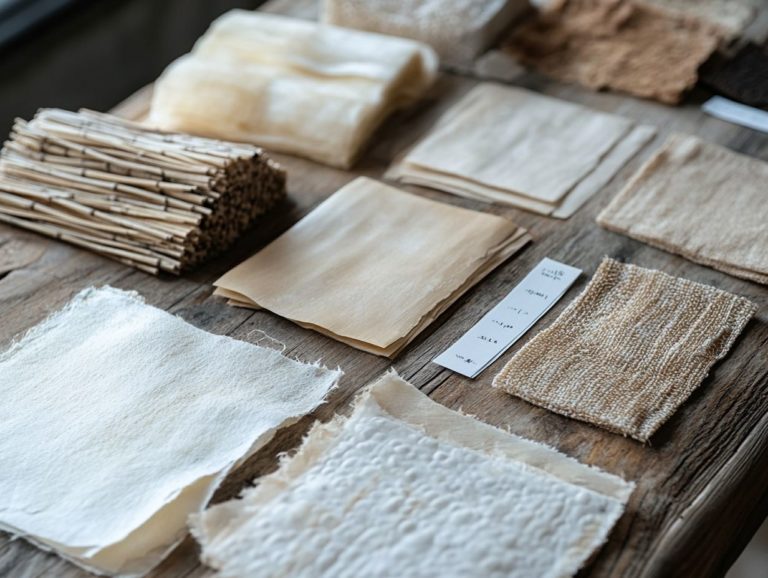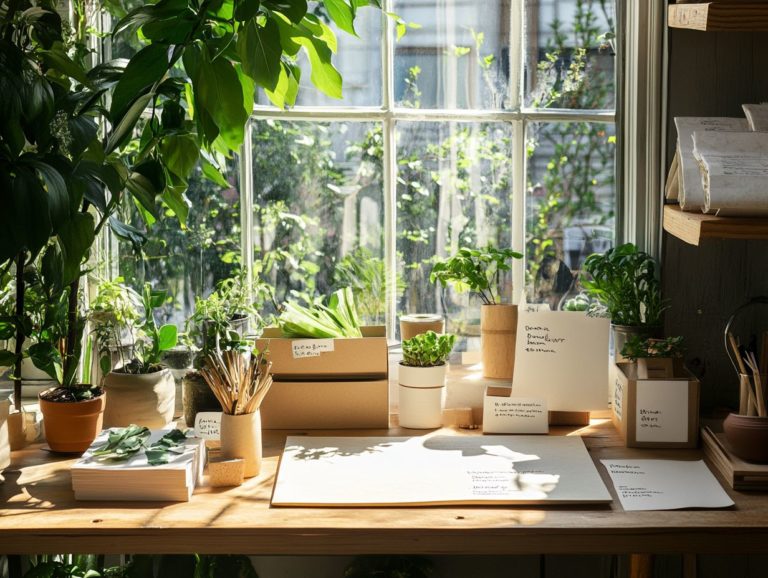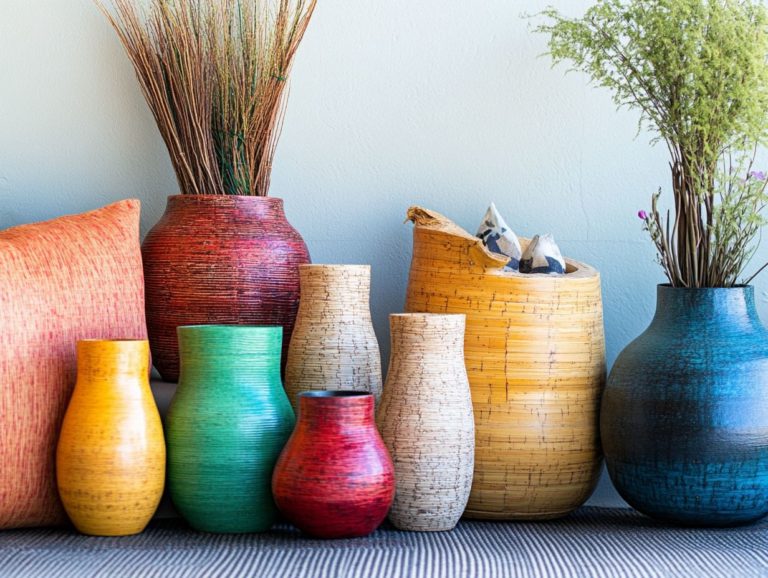Why Recycled Glass is a Sustainable Choice for Homes
Glass production significantly impacts our environment, and it s time we take action. This article explores the intricate processes involved in glass manufacturing and the urgent ecological issues that arise from this industry.
However, there s a silver lining: recycled glass presents a sustainable alternative that minimizes waste, conserves valuable resources, and reduces energy consumption. From everyday household items to innovative design applications, discover how to incorporate recycled glass into your home and contribute to positive change for our planet.
Contents
- Key Takeaways:
- The Environmental Impact of Glass Production
- The Benefits of Using Recycled Glass
- Reducing Waste and Energy Consumption
- Conserving Natural Resources
- Types of Recycled Glass Products
- Innovative Uses for Recycled Glass in Home Design
- How to Incorporate Recycled Glass into Your Home
- Frequently Asked Questions
- What is recycled glass and why is it considered a sustainable choice for homes?
- How is recycled glass used in homes?
- What makes recycled glass a better option than traditional materials for homes?
- Is recycled glass safe for use in homes?
- Do recycled glass products come in a variety of colors and styles?
- How can using recycled glass in homes benefit the environment?
Key Takeaways:

- By choosing recycled glass products for your home, you help reduce waste and energy consumption, contributing to a more sustainable environment.
- Recycled glass offers the same functionality and aesthetic appeal as traditional glass while conserving natural resources and reducing environmental impact.
- From common household items to innovative design elements, there are many ways to incorporate recycled glass into your home. Consider DIY projects or purchasing from companies that prioritize sustainability.
The Environmental Impact of Glass Production
The environmental impact of glass production raises significant sustainability issues that affect both biological systems and our natural resources. As industries confront escalating environmental challenges, it’s essential to engage in discussions about glass production and its implications for carbon emissions.
Organizations like the United Nations and the European Commission emphasize the urgency of addressing these challenges, highlighting the need to balance current demands with the well-being of future generations.
Overview of Glass Production Processes
The glass production process unfolds in several stages: sourcing raw materials, melting, forming, and annealing. These steps create the remarkable properties of glass that we often take for granted.
It begins with the careful selection of silica sand, soda ash, and limestone. These materials undergo a high-temperature transformation in furnaces, where chemical reactions occur, resulting in a molten state. This molten glass becomes a canvas for creativity, shaped through techniques like blowing, pressing, or molding. Once formed, the products are gradually cooled through annealing a process that strengthens the glass and reduces internal stresses.
Importantly, recycling glass is a vital aspect of this process. It conserves energy and significantly reduces emissions. The unique properties of glass its transparency, durability, and resistance to chemicals make it essential in everything from everyday containers to intricate architectural designs.
Environmental Concerns
The environmental concerns surrounding glass production are complex and multifaceted, ranging from high carbon emissions to the challenges of managing glass waste, all of which significantly affect sustainability efforts.
This process requires a substantial amount of energy, often sourced from fossil fuels, leading to a considerable carbon footprint that exacerbates climate change. Glass waste presents serious challenges; once discarded, it can remain in landfills for centuries, leaching harmful substances into the surrounding soil and water.
This scenario highlights the urgent need for effective recycling initiatives. Recycling diminishes waste volume and markedly reduces energy consumption during production. Embracing sustainable practices, such as using recycled materials and adopting energy-efficient technologies, is vital for lessening environmental impacts and fostering a circular economy within the glass industry.
The Benefits of Using Recycled Glass
Using recycled glass offers numerous advantages, especially in promoting sustainability and energy efficiency. By choosing recycled glass, you actively contribute to reducing landfill waste and conserving precious natural resources, making a positive impact on the environment.
To learn more about sustainable practices and explore recycled glass options, consider visiting local retailers or engaging in community initiatives that promote recycling.
Reducing Waste and Energy Consumption

Recycling glass is a powerful way to make a difference! It significantly reduces waste and lowers energy consumption because it requires much less energy than producing new glass from raw materials.
The process starts with the careful collection and sorting of glass items. These are then cleaned and crushed into small pieces called cullet, which is the small glass used to make new glass products.
By utilizing cullet, you decrease the need for raw materials and enable manufacturers to reduce the melting temperature. This leads to as much as 30% less energy usage.
This shift results in a more sustainable and environmentally friendly production cycle. Recycling glass also plays a vital role in reducing greenhouse gas emissions, contributing to a healthier planet.
As communities adopt these practices, they actively participate in fostering a circular economy. This ultimately benefits future generations and creates a lasting impact.
Conserving Natural Resources
Conserving natural resources is essential when recycling glass, especially through the use of cullet. This recycled glass serves as a substitute for raw materials in the glass production process.
By incorporating cullet into new glass manufacturing, you significantly reduce the demand for sand, soda ash, and limestone, which are the primary raw materials.
This approach minimizes the environmental impact of resource extraction and enhances energy efficiency. Melting cullet requires considerably less energy than working with virgin materials.
As a result, this practice helps lower greenhouse gas emissions and fosters a more sustainable production cycle. Ultimately, embracing these methods contributes to a greener industry.
Encouraging communities to engage in recycling programs genuinely benefits the planet.
Types of Recycled Glass Products
Recycled glass products present a diverse range of options, providing elegant, eco-friendly solutions for individuals eager to embrace a sustainable lifestyle.
By choosing these products, you enhance your living space and make a meaningful contribution to a greener planet.
Common Household Items Made from Recycled Glass
- Elegant tabletop decor
- Practical kitchenware
- Beautifully designed vases
- Dinnerware sets that infuse sophistication
- Glass containers ideal for storage
These items highlight their visual allure and promote eco-friendly living. This innovative design approach opens the door to a diverse array of products while minimizing waste and championing sustainability.
These items reflect the increasing shift toward environmentally conscious choices. They demonstrate how recycled materials can seamlessly integrate into everyday life, enhancing both functionality and style.
Innovative Uses for Recycled Glass in Home Design
Innovative uses for recycled glass in home design are gaining traction. Designers create stunning mosaics and various applications made possible through 3D printing technologies.
This forward-thinking approach elevates aesthetic appeal and champions sustainability by effectively reducing waste. You ll find designers experimenting with colors, textures, and patterns to craft unique pieces.
These can serve multiple purposes, from functional countertops to captivating wall installations. As new technologies emerge, the versatility of recycled glass expands, allowing for intricate designs that were once beyond reach.
The intersection of art and sustainability invites you to adopt a fresh perspective. Join us in making a difference by choosing recycled products today!
How to Incorporate Recycled Glass into Your Home

Ready to make your home more beautiful and eco-friendly? Let s explore how recycled glass can transform your space while aligning with a sustainable lifestyle. This choice offers a wealth of eco-friendly options, allowing you to create a beautiful environment that reflects your commitment to the planet.
Tips for Finding and Purchasing Recycled Glass Products
Finding and purchasing recycled glass products may require some knowledge and effort. However, the rewards are truly worth it for environmentally friendly shoppers like you seeking ethical options.
As you embark on this journey, explore various venues such as local artisan markets, specialty eco-stores, and reputable online retailers that prioritize sustainable sourcing. When shopping, pay close attention to labels that show eco-friendliness, ensuring that the manufacturers you support are dedicated to ethical practices and quality materials.
Engage with brands that are transparent about their production methods. Being diligent in your search supports green initiatives and helps reduce the environmental impact of waste in your home.
DIY Projects Using Recycled Glass
Get creative with DIY projects using recycled glass! Transform what might otherwise be waste into beautiful and functional pieces. Whether it s crafting charming glass candle holders, vibrant garden d cor, practical storage containers, or unique picture frames, the possibilities are virtually limitless.
To embark on this creative journey, start by gathering materials like clean glass bottles, jars, and decorative elements such as paints, twine, or stones. The process is simple: wash the glass, cut it if needed, and then assemble or decorate it to reflect your personal style.
Engaging with recycled glass in these inventive ways fosters a spirit of resourcefulness and underscores the significance of sustainability in your everyday life.
Frequently Asked Questions
What is recycled glass and why is it considered a sustainable choice for homes?
Recycled glass is broken or crushed glass that has been processed and repurposed for various applications. It is considered a sustainable choice for homes because it reduces the amount of waste sent to landfills and conserves natural resources.
How is recycled glass used in homes?

Recycled glass can be used in various ways, including as countertops, tiles, flooring, and decorative accents. It can also be used in landscaping and as insulation material.
What makes recycled glass a better option than traditional materials for homes?
Recycled glass has a lower environmental impact compared to traditional materials because it requires less energy and resources to produce. It also helps reduce the depletion of natural resources and decreases the amount of waste sent to landfills.
Is recycled glass safe for use in homes?
Yes, recycled glass is safe for use in homes. Recycled glass products undergo thorough testing and meet all safety standards before being sold for home use.
Do recycled glass products come in a variety of colors and styles?
Yes, recycled glass products come in a wide range of colors and styles, making it a versatile option for home design. From vibrant and bold colors to more muted and natural tones, there is a recycled glass product to fit any aesthetic.
How can using recycled glass in homes benefit the environment?
By using recycled glass in homes, we are reducing the demand for new materials and conserving natural resources. This helps decrease pollution, conserve energy, and protect the environment for future generations.






